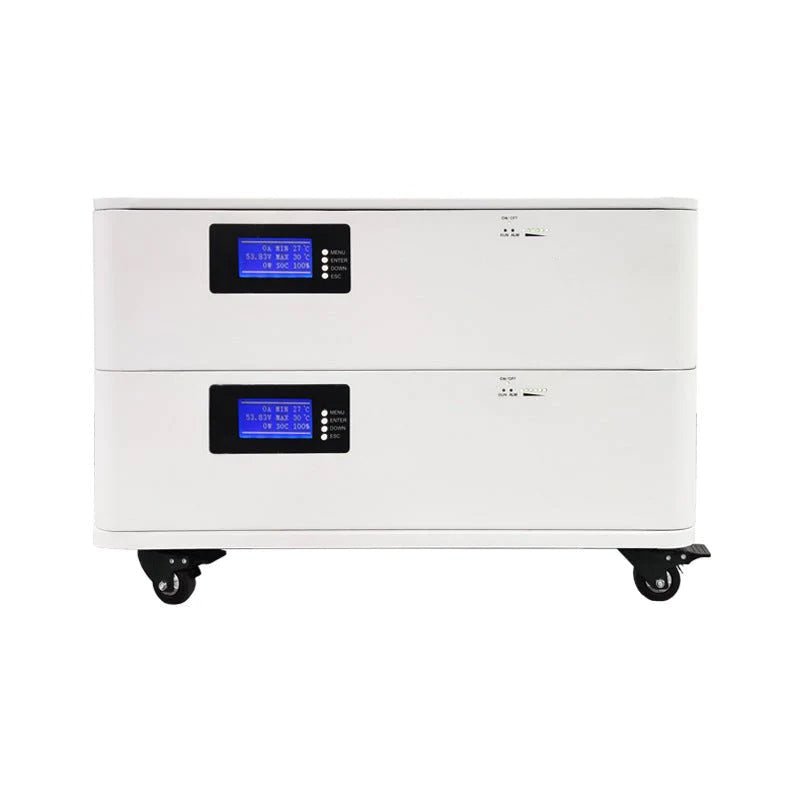In today's world, where sustainability and energy efficiency are becoming increasingly crucial, harnessing solar power has emerged as a viable solution for homeowners seeking to reduce their carbon footprint and lower utility bills. However, simply installing solar panels isn't always sufficient to meet all of your energy needs. This is where solar batteries come into play. Solar batteries store excess energy generated by your solar panels kit during the day, allowing you to use it during periods of low sunlight or at night.
Choosing the right solar batteries for your home energy storage is a critical decision that requires careful consideration of various factors. In this comprehensive guide, we will delve into the essential aspects of selecting the perfect solar batteries tailored to your specific requirements. From understanding the benefits of home energy storage to evaluating different types of batteries and assessing performance metrics, we'll equip you with the knowledge needed to make an informed decision.

1. Why Invest in Solar Batteries?
Solar batteries play a pivotal role in maximizing the efficiency and effectiveness of your solar power system. Let's explore the compelling reasons why investing in solar batteries is a wise decision.
What are the Benefits of Home Energy Storage?
Home energy storage, facilitated by solar batteries, offers a multitude of benefits for homeowners looking to optimize their energy usage and reduce reliance on the grid. Here's a closer look at some key advantages:
Energy Independence: By storing excess solar energy generated during the day, you can reduce your dependence on the grid, especially during peak hours or in areas prone to power outages. This provides a sense of security and reliability, knowing that you have a backup power source readily available.
Maximized Solar Utilization: Without a battery storage system, surplus solar energy not used immediately is typically exported back to the grid, often at lower rates than what you would pay for electricity. With solar batteries, you can store this excess energy for later use, maximizing self-consumption and reducing reliance on grid-supplied electricity.
Load Shifting: Solar batteries enable load shifting, allowing you to use stored energy during times of high electricity demand or when utility rates are at their peak. This can result in significant cost savings by avoiding expensive peak-hour tariffs and reducing overall electricity bills.
Backup Power During Outages: One of the most significant advantages of solar batteries is their ability to provide backup power during grid outages. This is particularly beneficial for areas prone to extreme weather events or unreliable grid infrastructure, ensuring that essential appliances and devices remain powered during emergencies.
Environmental Benefits: By utilizing solar energy and storing it with batteries, homeowners can significantly reduce their carbon footprint and contribute to a cleaner, more sustainable future. Solar power is a renewable energy source that produces no greenhouse gas emissions during operation, unlike fossil fuels.
How Can Solar Batteries Save You Money?
Solar batteries offer several avenues for saving money on energy costs over the long term. Let's explore how incorporating solar batteries into your home energy system can lead to financial benefits:
Reduced Electricity Bills: By storing excess solar energy and using it during peak demand periods or at night, you can significantly reduce your reliance on grid-supplied electricity. This can result in lower electricity bills over time, as you draw less power from the grid and rely more on your stored solar energy.
Avoidance of Peak Hour Tariffs: Many utility companies implement time-of-use pricing, where electricity rates are higher during peak demand hours and lower during off-peak hours. Solar batteries allow you to store excess energy when rates are low and use it when rates are high, effectively avoiding peak-hour tariffs and saving money on electricity costs.
Maximized Self-Consumption: Without battery storage, surplus solar energy not used immediately is often exported back to the grid, typically at lower rates than what you would pay for electricity. By storing this excess energy with solar batteries, you can maximize self-consumption and minimize the need to purchase electricity from the grid, resulting in additional savings.
Increased Energy Independence: Investing in solar batteries enhances your energy independence by reducing your reliance on the grid. This means you're less affected by fluctuations in utility rates and potential power outages, providing long-term financial stability and peace of mind.
Long-Term Return on Investment (ROI): While the initial cost of purchasing and installing solar batteries may seem daunting, it's essential to consider the long-term ROI. Over time, the savings generated from reduced electricity bills, avoided peak-hour tariffs, and increased self-consumption can offset the upfront investment, leading to substantial financial gains.
Are Solar Batteries Worth the Investment?
Investing in solar batteries represents a significant financial commitment for homeowners, prompting the question: Are solar batteries worth the investment? Let's examine key factors to consider when evaluating the value proposition of solar batteries:
Energy Needs and Usage Patterns: Assessing your household's energy needs and usage patterns is crucial in determining whether solar batteries are worth the investment. If you have high energy consumption, especially during peak hours or at night, solar batteries can provide substantial savings by storing excess solar energy for later use.
Electricity Costs and Tariffs: The cost of electricity from the grid and the structure of utility tariffs in your area play a significant role in determining the potential savings from solar batteries. High electricity rates and peak-hour tariffs make solar batteries more financially attractive, as they allow you to avoid expensive grid-supplied electricity during peak demand periods.
Availability of Incentives and Rebates: Government incentives, tax credits, and utility rebates can significantly reduce the upfront cost of purchasing and installing solar batteries, making them more financially viable for homeowners. It's essential to research available incentives in your area and factor them into your cost-benefit analysis.
System Longevity and Performance: Consider the expected lifespan and performance of the solar battery system you're considering. High-quality batteries with longer lifespans and reliable performance are more likely to provide a favorable return on investment over the long term, compared to cheaper, less durable options.
Resale Value and Home Equity: Installing solar batteries can enhance the resale value and marketability of your home, as it appeals to eco-conscious buyers and demonstrates a commitment to sustainability. Additionally, some studies suggest that homes equipped with solar panels and batteries command higher resale prices and attract more potential buyers.
Environmental Impact: While the financial return on investment is essential, it's also crucial to consider the environmental impact of investing in solar batteries. By reducing reliance on fossil fuels and lowering carbon emissions, solar batteries contribute to a cleaner, more sustainable future for generations to come.
2. What Factors Should You Consider?
When it comes to selecting the right solar batteries for your home energy storage system, several key factors must be taken into account. Let's delve into these considerations to ensure you make an informed decision tailored to your specific needs.
What is Your Energy Consumption Pattern?
Understanding your household's energy consumption pattern is crucial in determining the size and capacity of the solar battery system you require. Analyze your electricity usage over different times of the day and identify peak demand periods when you consume the most energy. This information will help you determine the storage capacity needed to meet your household's energy needs efficiently.
For example, if your energy consumption is highest in the evenings when solar generation is minimal, you'll require a larger battery capacity to store excess energy generated during the day for use during peak demand hours. On the other hand, if your energy usage is relatively consistent throughout the day, a smaller battery system may suffice.
Consider installing energy monitoring systems or smart meters to track your energy usage accurately and identify patterns over time. This data will be invaluable in sizing your solar battery system appropriately and optimizing its performance.
How Much Storage Capacity Do You Need?
Determining the storage capacity of your solar battery system involves balancing your energy consumption requirements with the size of your solar panel array and the availability of sunlight in your area. A larger battery capacity allows for greater energy autonomy and resilience during periods of low solar generation or grid outages but comes with higher upfront costs.
To calculate your storage capacity needs, consider factors such as:
- Average daily energy consumption (kWh/day)
- Peak demand periods and duration
- Expected solar generation and sunlight availability
- Desired level of energy independence and backup power capability
Consulting with a solar energy professional or using online calculators can help you estimate the optimal storage capacity for your specific requirements. It's essential to strike a balance between meeting your energy needs and staying within your budget constraints when selecting the size of your solar battery system.
What Are the Physical Constraints of Your Property?
Before investing in solar batteries, assess the physical constraints of your property, including available space for battery installation, environmental conditions, and local regulations. Solar batteries come in various sizes and configurations, ranging from compact wall-mounted units to larger outdoor enclosures, so it's essential to choose a system that fits your space requirements.
Consider factors such as:
- Available indoor or outdoor space for battery installation
- Ventilation and temperature control requirements
- Structural integrity and weight-bearing capacity of installation site
- Accessibility for maintenance and servicing
- Compliance with local building codes and zoning regulations
Additionally, evaluate environmental factors such as exposure to sunlight, shading from nearby structures or vegetation, and climatic conditions that may affect battery performance and longevity. Proper siting and installation of solar batteries are critical to ensuring optimal performance and longevity while minimizing potential safety hazards.
By carefully considering your energy consumption pattern, storage capacity needs, and physical constraints of your property, you can make an informed decision when selecting solar batteries for your whole home backup battery. Consulting with solar energy experts and conducting a thorough site assessment will help you navigate these considerations and choose the right solution for your specific requirements.
3. Which Type of Solar Battery is Best for You?
Selecting the most suitable type of solar battery for your home energy storage system is crucial to ensure optimal performance, longevity, and cost-effectiveness. Let's explore the various types of solar batteries available on the market and their respective advantages and disadvantages.
Lead Acid Batteries: Pros and Cons
Lead acid batteries have been used for decades in off-grid and backup power applications, offering a reliable and cost-effective energy storage solution. Here are some key pros and cons of lead acid batteries:
Pros:
Affordability: Lead acid batteries are relatively inexpensive compared to other battery chemistries, making them an attractive option for homeowners on a budget.
Proven Technology: Lead acid batteries have a long track record of reliability and performance in various applications, providing peace of mind to homeowners.
Wide Availability: Lead acid batteries are readily available from numerous manufacturers and suppliers, making them easy to procure for residential installations.
Cons:
Limited Cycle Life: Lead acid batteries typically have a shorter lifespan and lower cycle life compared to other battery chemistries, requiring more frequent replacements and maintenance.
Lower Energy Density: Lead acid batteries have lower energy density, meaning they require more space and weight for the same storage capacity compared to other battery types.
Maintenance Requirements: Lead acid batteries require regular maintenance, including topping up electrolyte levels, equalizing charges, and monitoring for sulfation and corrosion.
While lead acid batteries offer affordability and reliability, their shorter lifespan and higher maintenance requirements may make them less suitable for homeowners seeking a long-term energy storage solution with minimal upkeep.
Lithium-ion Batteries: Advantages and Disadvantages
Lithium-ion batteries have gained popularity in recent years due to their high energy density, long cycle life, and superior performance. Here are some advantages and disadvantages of lithium-ion batteries:
Advantages:
High Energy Density: Lithium-ion batteries offer high energy density, allowing for compact and lightweight designs with greater storage capacity compared to lead acid batteries.
Long Cycle Life: Lithium-ion batteries have a longer lifespan and higher cycle life than lead acid batteries, requiring less frequent replacements and maintenance.
Fast Charging: Lithium-ion batteries can be charged and discharged at a faster rate than lead acid batteries, making them ideal for applications requiring rapid energy storage and release.
Disadvantages:
Higher Initial Cost: Lithium-ion batteries tend to have a higher upfront cost compared to lead acid batteries, although prices have been declining as technology advances and economies of scale improve.
Safety Concerns: While lithium-ion batteries are generally safe when handled properly, they can pose a fire risk if damaged, overcharged, or exposed to high temperatures. Proper installation and monitoring are essential to mitigate these risks.
Complex Recycling Process: Lithium-ion batteries require specialized recycling processes to recover valuable materials and minimize environmental impact, posing challenges for end-of-life disposal and recycling.
Despite the higher initial cost and safety considerations, lithium-ion batteries offer superior performance, longer lifespan, and lower maintenance requirements, making them an attractive option for homeowners seeking a reliable and efficient energy storage solution.
Flow Batteries: Is It the Right Choice for Your Home?
Flow batteries are a relatively new technology gaining attention for their scalability, long cycle life, and flexibility. Here's an overview of the advantages and disadvantages of flow batteries:
Advantages:
Scalability: Flow batteries offer excellent scalability, allowing for easy expansion of storage capacity by simply adding more electrolyte fluid, making them suitable for large-scale energy storage applications.
Long Cycle Life: Flow batteries have a long cycle life, with the potential for thousands of charge-discharge cycles, resulting in reduced maintenance and replacement costs over time.
Deep Discharge Capability: Flow batteries can be discharged to very low levels without significant degradation, making them suitable for applications requiring deep cycling and prolonged energy storage.
Disadvantages:
Complexity: Flow batteries are more complex and less mature than traditional battery technologies like lead acid and lithium-ion, requiring sophisticated control systems and specialized maintenance procedures.
Lower Energy Density: Flow batteries typically have lower energy density than lithium-ion batteries, resulting in larger and heavier systems for the same storage capacity.
Higher Cost: Flow batteries tend to have a higher upfront cost compared to other battery types, although ongoing research and development efforts aim to reduce costs and improve efficiency.
While flow batteries offer scalability and long cycle life, their complexity, lower energy density, and higher cost may make them less suitable for residential applications compared to more established battery technologies like lithium-ion.
4. How to Assess Battery Performance?
Assessing the performance of solar batteries is crucial to ensure reliable operation, optimal energy storage, and long-term cost-effectiveness. Let's explore the key metrics and factors to consider when evaluating battery performance.
Understanding Battery Efficiency Ratings
Battery efficiency is a critical metric that determines how effectively a battery can convert stored energy into usable electricity and vice versa. Higher efficiency means less energy loss during charging and discharging cycles, resulting in more efficient energy storage and utilization. Here's how to interpret battery efficiency ratings:
Charge Efficiency: Charge efficiency measures how efficiently a battery can absorb energy during the charging process. It is expressed as a percentage and indicates the proportion of energy input that is effectively stored in the battery. Higher charge efficiency values signify less energy loss during charging.
Discharge Efficiency: Discharge efficiency measures how efficiently a battery can deliver stored energy during the discharging process. It is also expressed as a percentage and indicates the proportion of stored energy that is effectively converted into usable electricity. Higher discharge efficiency values indicate less energy loss during discharging.
Round-Trip Efficiency: Round-trip efficiency measures the overall efficiency of a battery system by considering both charge and discharge processes. It represents the ratio of usable energy output to energy input during a complete charge-discharge cycle. Higher round-trip efficiency values indicate less energy loss over the entire charging and discharging process.
When evaluating battery performance, prioritize batteries with high efficiency ratings to maximize energy storage and utilization while minimizing energy losses and operating costs.
Evaluating Battery Lifespan and Warranty
Battery lifespan and warranty are critical considerations when assessing the long-term reliability and cost-effectiveness of solar batteries. Here's what to look for:
Cycle Life: Cycle life refers to the number of charge-discharge cycles a battery can endure before reaching the end of its useful life. Higher cycle life values indicate greater durability and longevity. It's essential to choose batteries with sufficient cycle life to meet your expected usage and avoid frequent replacements.
Calendar Life: Calendar life refers to the total time span a battery can remain operational, regardless of the number of charge-discharge cycles. It is affected by factors such as temperature, depth of discharge, and storage conditions. Batteries with longer calendar life can provide reliable performance over extended periods, reducing the need for premature replacements.
Warranty Coverage: Pay attention to the warranty coverage offered by battery manufacturers, including warranty duration and terms. A comprehensive warranty should cover defects in materials and workmanship, as well as performance degradation over time. Longer warranty periods and favorable terms provide added assurance of product quality and reliability.
When comparing battery options, prioritize batteries with longer cycle life, calendar life, and warranty coverage to ensure reliable performance and protection against premature failures or performance degradation.
Analyzing Depth of Discharge and Cycle Life
Depth of discharge (DoD) is a critical factor that influences solar battery lifespan and performance. DoD refers to the percentage of a battery's capacity that has been discharged relative to its total capacity. Here's how DoD affects battery cycle life:
Shallow Cycling: Shallow cycling, where batteries are discharged to only a small percentage of their total capacity, can prolong battery life and improve cycle life. Limiting DoD to 20-30% or less can significantly extend battery lifespan and reduce the risk of capacity degradation over time.
Deep Cycling: Deep cycling, where batteries are discharged to a higher percentage of their total capacity, can shorten battery life and decrease cycle life. Excessive DoD, especially above 50%, accelerates chemical degradation and increases the risk of irreversible capacity loss and premature failure.
Optimal DoD: Balancing the depth of discharge with battery capacity and usage patterns is essential to maximize cycle life and maintain long-term performance. Aim to operate batteries within their optimal DoD range to achieve the best combination of energy storage, efficiency, and longevity.
When designing and operating a solar battery system, consider factors such as DoD, cycling frequency, and charging/discharging profiles to optimize battery performance, extend lifespan, and maximize return on investment.
5. What Are the Installation Considerations?
Installing solar batteries requires careful planning and consideration of various factors to ensure optimal performance, safety, and compliance with regulatory requirements. Let's explore the key installation considerations for integrating solar batteries into your home energy system.
Space Requirements for Battery Installation
Determining the appropriate space for battery installation is essential to ensure proper ventilation, access for maintenance, and compliance with building codes. Consider the following factors when planning the layout and location of your solar batteries:
Indoor vs. Outdoor Installation: Solar batteries can be installed indoors or outdoors, depending on available space, environmental conditions, and local regulations. Indoor installations offer protection from the elements and may require less structural reinforcement but require adequate ventilation and space clearance to dissipate heat and prevent thermal buildup. Outdoor installations require weatherproof enclosures and protection from temperature extremes, moisture, and pests.
Clearance Requirements: Ensure sufficient clearance around the battery system to allow for ventilation, cooling, and maintenance access. Follow manufacturer recommendations and local building codes regarding minimum clearance distances from walls, ceilings, and other obstructions to prevent overheating and ensure safe operation.
Structural Support: Assess the structural integrity of the installation site to support the weight of the battery system, including the batteries themselves, mounting brackets or racks, and any additional equipment. Reinforce floors, walls, or supports as needed to accommodate the weight and ensure stability and safety.
Ventilation and Airflow: Provide adequate ventilation and airflow around the battery system to dissipate heat generated during charging and discharging cycles. Install vents, fans, or ducts as necessary to promote air circulation and prevent overheating, especially in confined or enclosed spaces.
Accessibility: Ensure easy access to the battery system for maintenance, servicing, and emergency shutdown procedures. Install the batteries in a location that allows for safe and convenient inspection, troubleshooting, and replacement of components as needed.
By carefully considering space requirements and installation considerations, you can ensure a safe, efficient, and compliant integration of solar batteries into your home energy system.
Integration with Existing Solar Power Systems
If you already have a solar power system installed on your property, integrating solar batteries requires careful coordination and compatibility assessment to optimize performance and functionality. Here are some key considerations when integrating solar batteries with existing solar power systems:
System Compatibility: Ensure compatibility between the solar batteries and your existing solar power system in terms of voltage, capacity, and communication protocols. Consult with your solar installer or battery manufacturer to confirm compatibility and identify any additional components or modifications required for seamless integration.
Inverter and Charge Controller Compatibility: Assess compatibility between the existing solar inverter, solar charge controller, and the new battery system to ensure proper communication and coordination between components. Some battery systems may require compatible inverters or charge controllers for optimal performance and efficiency.
Energy Management System: Consider implementing an energy management system (EMS) or smart energy monitoring platform to optimize the operation of your solar power system and battery storage. An EMS can intelligently control energy flow, prioritize energy use, and maximize self-consumption to minimize reliance on grid-supplied electricity and maximize savings.
System Expansion: Evaluate the scalability and expandability of your existing solar power system to accommodate additional solar panels or batteries in the future. Plan for future growth and capacity upgrades to meet evolving energy needs and technological advancements.
By ensuring compatibility, coordinating system components, and planning for future expansion, you can seamlessly integrate solar batteries with your existing solar power system and maximize the benefits of renewable energy storage and utilization.
Safety Measures and Regulatory Compliance
Ensuring the safety of your solar battery installation and compliance with local building codes and regulations is paramount to protect your property, occupants, and the surrounding environment. Here are essential safety measures and regulatory requirements to consider:
Electrical Safety: Follow all electrical safety guidelines and standards when installing, wiring, and commissioning solar batteries. Use proper grounding, insulation, and protective devices to prevent electrical hazards, such as electric shocks, short circuits, and fires.
Fire Safety: Implement fire safety measures, such as installing smoke detectors, fire extinguishers, and fire-resistant barriers or enclosures around the battery system to contain and mitigate fire risks. Ensure proper ventilation and thermal management to minimize the risk of overheating and thermal runaway.
Permitting and Inspections: Obtain necessary permits and approvals from local authorities or building departments before installing solar batteries. Schedule inspections to verify compliance with building codes, electrical regulations, and safety standards, including structural integrity, electrical wiring, and fire protection.
Manufacturer Recommendations: Follow manufacturer recommendations and guidelines for proper installation, operation, and maintenance of solar batteries. Adhere to specified installation procedures, environmental conditions, and operational limits to ensure warranty coverage and optimal performance.
By adhering to safety measures, regulatory requirements, and manufacturer recommendations, you can ensure a safe, compliant, and reliable installation of solar batteries on your property.
6. How to Compare Pricing and Return on Investment (ROI)?
Comparing pricing and evaluating the return on investment (ROI) of solar batteries requires careful analysis of upfront costs, ongoing expenses, and potential savings over time. Let's explore how to compare pricing and calculate the ROI of solar batteries effectively.
Initial Cost vs. Long-term Savings Analysis
When assessing the pricing of solar batteries, it's essential to consider both the upfront cost of purchasing and installing the battery system and the long-term savings it can generate. Here's how to conduct an initial cost vs. long-term savings analysis:
Upfront Cost: Determine the total upfront cost of purchasing and installing the solar battery system, including equipment, labor, permits, and any additional components or accessories. Obtain quotes from multiple suppliers and installers to compare prices and negotiate discounts or incentives.
Ongoing Expenses: Estimate the ongoing expenses associated with operating and maintaining the solar battery system, such as electricity costs for charging and discharging, monitoring and maintenance fees, and warranty coverage. Factor in any potential price increases or changes in utility tariffs over time.
Savings Potential: Calculate the potential savings generated by the solar battery system over its lifespan, including reduced electricity bills, avoided peak-hour tariffs, incentives or rebates, and increased energy independence. Consider factors such as energy consumption patterns, utility rates, and system performance to estimate savings accurately.
Payback Period: Determine the payback period for the solar battery system by dividing the total upfront cost by the annual savings generated. A shorter payback period indicates a higher ROI and faster recoupment of investment costs. Consider factors such as financing options, tax credits, and incentives that may accelerate the payback period.
By comparing upfront costs with long-term savings potential and calculating the payback period, you can assess the affordability and cost-effectiveness of solar batteries and make an informed investment decision.
Financing Options and Incentives Available
Exploring financing options and incentives can help reduce the upfront cost of purchasing and installing solar batteries and improve the overall ROI. Consider the following financing options and incentives available for solar battery investments:
Government Incentives: Research available government incentives, tax credits, grants, and rebates for solar energy and energy storage installations. Many governments offer financial incentives to encourage renewable energy adoption and support energy storage technologies.
Utility Rebates: Check with your local utility company for any available rebates, incentives, or financing programs specifically for solar battery installations. Some utilities offer cash rebates, discounted rates, or financing options to offset the cost of battery systems and promote grid resilience.
Financing Programs: Explore financing programs such as solar loans, lease-to-own agreements, or power purchase agreements (PPAs) offered by solar installers, financial institutions, or third-party providers. These programs can help spread out the upfront cost of solar batteries over time and make them more accessible to homeowners.
Tax Credits and Deductions: Take advantage of available tax credits and deductions for solar energy and energy storage investments. Depending on your location and tax status, you may be eligible for federal, state, or local tax incentives that can significantly reduce the cost of installing solar batteries.
By leveraging financing options and incentives, you can lower the upfront cost of solar batteries and improve the overall ROI, making them a more attractive and affordable investment for homeowners.
Calculating the Payback Period for Different Battery Options
Calculating the payback period for different solar battery options involves comparing the total upfront cost of each system with the annual savings generated and determining how long it takes to recoup the initial investment. Here's how to calculate the payback period:
Total Upfront Cost: Determine the total upfront cost of purchasing and installing each solar battery system, including equipment, labor, permits, and additional expenses. Obtain quotes from multiple suppliers and installers to compare prices and options.
Annual Savings: Estimate the annual savings generated by each solar battery system, including reduced electricity bills, avoided peak-hour tariffs, incentives or rebates, and increased energy independence. Consider factors such as energy consumption patterns, utility rates, and system performance.
Payback Period Calculation: Divide the total upfront cost of each solar battery system by the annual savings generated. The resulting figure represents the number of years it takes to recoup the initial investment through energy savings. A shorter payback period indicates a higher ROI and faster return on investment.
Comparison and Decision Making: Compare the payback periods for different solar battery options to identify the most cost-effective solution for your specific needs and budget. Consider factors such as system performance, warranty coverage, and financing options when making your decision.
By calculating the payback period for different solar battery options, you can assess their affordability, cost-effectiveness, and return on investment, helping you make an informed decision that maximizes savings and benefits over time.

7. Where to Find Reliable Suppliers and Installers?
Finding reliable suppliers and installers is crucial to ensuring the quality, performance, and safety of your solar battery installation. Here's how to locate reputable suppliers and installers for your solar energy needs.
Researching and Vetting Solar Battery Manufacturers
Researching and vetting solar battery manufacturers is the first step in finding reliable suppliers for your solar energy system. Consider the following factors when evaluating manufacturers:
Reputation and Experience: Choose reputable manufacturers with a proven track record of delivering high-quality, reliable solar battery products. Look for manufacturers with years of experience in the industry and positive reviews from customers and industry experts.
Product Quality and Performance: Assess the quality and performance of the solar battery products offered by manufacturers. Look for certifications, such as UL certification, ISO accreditation, and performance ratings from independent testing organizations, to ensure product reliability and compliance with industry standards.
Technology and Innovation: Consider manufacturers that invest in research and development to continuously improve their products and incorporate cutting-edge technology and innovations. Look for features such as advanced battery chemistry, intelligent energy management systems, and remote monitoring capabilities that enhance performance and functionality.
Warranty and Support: Review the warranty coverage and customer support services offered by manufacturers. Choose manufacturers that provide comprehensive warranties, responsive customer support, and timely assistance with troubleshooting, maintenance, and warranty claims.
By researching and vetting solar battery manufacturers thoroughly, you can select a reliable supplier that offers high-quality products, excellent performance, and reliable support.
Choosing Qualified Installation Professionals
Selecting qualified installation professionals is essential to ensure the proper design, installation, and commissioning of your solar battery system. Consider the following factors when choosing installers:
Certifications and Credentials: Look for installers who are certified and accredited by recognized industry organizations, such as the North American Board of Certified Energy Practitioners (NABCEP) or the Solar Energy Industries Association (SEIA). Certification indicates that installers have undergone rigorous training and meet industry standards for quality and professionalism.
Experience and Expertise: Choose installers with extensive experience and expertise in designing and installing solar energy systems, including battery storage. Review their portfolio of past projects, customer testimonials, and case studies to assess their capabilities and track record of success.
Licensing and Insurance: Verify that installers are properly licensed, bonded, and insured to perform solar battery installations in your area. Licensing ensures that installers comply with local building codes, regulations, and safety standards, while insurance protects you and your property against potential liabilities and risks.
References and Recommendations: Seek recommendations from friends, family, or colleagues who have installed solar energy systems with battery storage. Ask for references from installers and contact past customers to inquire about their experiences, satisfaction with the installation process, and performance of the system.
By choosing qualified installation professionals with the necessary certifications, experience, and credentials, you can ensure a smooth, efficient, and successful installation of your solar battery system.
Seeking Recommendations and Reading Customer Reviews
Seeking recommendations and reading customer reviews can provide valuable insights and firsthand experiences from homeowners who have installed solar energy systems with battery storage. Consider the following sources when seeking recommendations and reviews:
Word of Mouth: Ask friends, family, neighbors, or colleagues who have installed solar energy systems with battery storage for recommendations and insights. Personal recommendations can provide valuable insights and help you identify reputable suppliers and installers.
Online Reviews and Ratings: Read online reviews and ratings from reputable sources, such as consumer review websites, industry forums, and social media platforms. Look for feedback from homeowners who have installed solar battery systems and pay attention to their experiences, satisfaction levels, and any issues encountered during the installation or operation.
Professional Associations and Networks: Consult professional associations, industry networks, and advocacy groups for recommendations and referrals to reputable suppliers and installers in your area. These organizations often maintain directories of certified professionals and uphold standards of professionalism and quality.
By seeking recommendations and reading customer reviews, you can gather valuable insights, assess the reputation and reliability of suppliers and installers, and make an informed decision that meets your needs and expectations.
In summary, finding reliable suppliers and installers for your solar battery installation requires thorough research, careful vetting, and consideration of factors such as reputation, experience, certifications, and customer feedback. By choosing reputable manufacturers and qualified installation professionals, you can ensure a successful, reliable, and cost-effective solar energy system with battery storage.
This concludes our comprehensive guide on how to choose solar batteries for your home energy storage system. We've covered essential aspects such as understanding the benefits of home energy storage, evaluating different types of solar batteries, assessing performance metrics, considering installation considerations, comparing pricing and ROI, and finding reliable suppliers and installers. With this knowledge, you're equipped to make an informed decision and optimize your solar power system with the right batteries.
If you have any further questions or need assistance, feel free to reach out. Thank you for reading, and best of luck with your solar energy journey!







